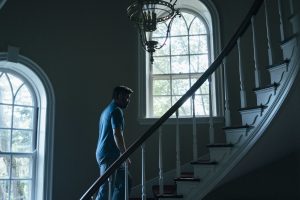![]() Director Yorgos Lanthimos made a name for himself two years ago with his first English-language film, the surreal and bizarrely entertaining dark comedy, The Lobster. Say what you will about that polarizing movie, but it was completely unique and entirely original from beginning to end. His latest, The Killing of a Sacred Deer, is an even grimmer and stranger affair.
Director Yorgos Lanthimos made a name for himself two years ago with his first English-language film, the surreal and bizarrely entertaining dark comedy, The Lobster. Say what you will about that polarizing movie, but it was completely unique and entirely original from beginning to end. His latest, The Killing of a Sacred Deer, is an even grimmer and stranger affair.
 Steven Murphy (Colin Farrell) is a surgeon who enjoys a very successful practice and seemingly perfect family unit, living in a ornate home with wife Anna (Nicole Kidman), and two children (Raffey Cassidy and Sunny Suljik). However, as the story begins, Steven appears to be spending a lot of time with a teenage boy named Martin (Barry Keoghan), showering him with valuable gifts. It is revealed that Martin is the son of a patient who died on the operating table. Events take a serious turn when the youth tells Steven that one of the Murphy clan must be sacrificed to balance out the untimely death of his father. If the surgeon does nothing, every member of the family will become ill and slowly die.
Steven Murphy (Colin Farrell) is a surgeon who enjoys a very successful practice and seemingly perfect family unit, living in a ornate home with wife Anna (Nicole Kidman), and two children (Raffey Cassidy and Sunny Suljik). However, as the story begins, Steven appears to be spending a lot of time with a teenage boy named Martin (Barry Keoghan), showering him with valuable gifts. It is revealed that Martin is the son of a patient who died on the operating table. Events take a serious turn when the youth tells Steven that one of the Murphy clan must be sacrificed to balance out the untimely death of his father. If the surgeon does nothing, every member of the family will become ill and slowly die.
In case you’re wondering, despite all of Steven’s efforts to find a medical explanation, there’s no real reason for how this is happening. It only becomes apparent that the universe seems to be on Martin’s side and is allowing these almost supernatural events to transpire. However, due to the gift-giving behavior and a suggestion that the surgeon had an alcohol problem in the past implies that despite protestations, his actions are that of a guilty man.
 This is an austere and cold movie, with its characters behaving in a peculiar and icy manner. Behind the curtain of a prefect family, we witness some very odd behavior from the protagonist. To be aroused in the bedroom, he appears to insist that his spouse behave in a manner similar to being anesthetized. And there’s a stiff formality to the lives of this professional that comes across in the performance and in the photography. Wide angles and long takes are used frequently, following the character down white, sanitary hospital corridors and through his spotless home.
This is an austere and cold movie, with its characters behaving in a peculiar and icy manner. Behind the curtain of a prefect family, we witness some very odd behavior from the protagonist. To be aroused in the bedroom, he appears to insist that his spouse behave in a manner similar to being anesthetized. And there’s a stiff formality to the lives of this professional that comes across in the performance and in the photography. Wide angles and long takes are used frequently, following the character down white, sanitary hospital corridors and through his spotless home.
While much of the movie is strange and at numerous times disturbing, there are some brutally amusing moments of grim black comedy. The lead’s stiff behavior plays as very humorous as he attempts to maintain a sense of normalcy amidst the horror occurring around him. It’s also funny to see Steven deflect blame by complaining that anesthesiologists are responsible for all deaths on the operating table, while an anesthesiologist is heard blaming surgeons. Perhaps the oddest moment involves a trip to school, where the lead not-so-causally questions his children’s instructor about which child is the better student. Even more strangeness is derived from the family members attempting to curry favor with their father so that he will not choose them to die.
 In the end, it appears that the film’s intentions are simply to use an unreal scenario to comment on the dysfunction and problems present within the traditional family unit. Steven never appears willing to admit to his mistakes or take personal responsibility for them; as a result, the entire family suffers. As one might have guessed, despite the occasional laugh, the overall feeling here is very dark and disturbing.
In the end, it appears that the film’s intentions are simply to use an unreal scenario to comment on the dysfunction and problems present within the traditional family unit. Steven never appears willing to admit to his mistakes or take personal responsibility for them; as a result, the entire family suffers. As one might have guessed, despite the occasional laugh, the overall feeling here is very dark and disturbing.
It’s an even stranger more unsettling effort than The Lobster. Although to be honest, the previous film is more effective. This follow-up moves at a slower, more protracted rate and in several respects appears to cover similar themes explored previously (I always felt that The Lobster critiqued social codes and the strange ways we are encouraged to select our companions and spouses).
Yet, while it isn’t quite as captivating, this reviewer can honestly say that the movie was original in its own way and just as unpredictable. The Killing of a Sacred Deer is guaranteed to frustrate and annoy the majority of those who watch it, but credit must be given to it for being bizarrely compelling while it spins in circles to a grim and inescapable finale.


